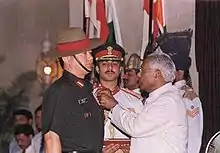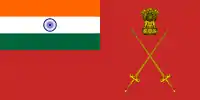11th Gorkha Rifles
The 11 Gorkha Rifles is a Gorkha regiment of the Indian Army that was re-raised after independence. The regiment consists of primarily the Kirati Tribes Rai and Limbu of Nepal and north-eastern India. It also recruits from Indian Gorkhas and Bhutias from Darjeeling district, West Bengal and Sikkim. Though it is considered to be the youngest of the Gorkha regiments its lineage is as long as those of the 7th Gurkha Rifles and 10th Gurkha Rifles.
| 11th Gorkha Rifles | |
|---|---|
 11th Gorkha Rifles Regiment insignia | |
| Active | 1948 – present |
| Country | |
| Branch | |
| Type | Rifles |
| Role | Light Infantry |
| Size | 6 Battalions |
| Regimental Centre | Lucknow, Uttar Pradesh |
| Nickname(s) | Kiranti |
| Motto(s) | Yatraham Vijayastatra (We are the Metaphor for Victory) |
| Decorations | 1 Param Vir Chakra 1 Military Crosses 3 Ashoka Chakras 1 Padma Bhushan 7 Param Vishist Seva Medals 2 Maha Vir Chakras 9 Ati Vishist Seva Medals 11 Vir Chakras 5 Shaurya Chakras 35 Sena Medals 14 Vishisht Seva Medals 18 Mentioned-in-Despatches |
| Battle honours | Shingo River, Bogra and Batalik Theater Honours: East Pakistan 1971 and J&K 1971 |
| Commanders | |
| Ceremonial chief | Colonel of the Regiment |
| Colonel of the Regiment | Lt Gen Anil Chauhan |
| Notable commanders | Gen Bipin Rawat |
| Insignia | |
| Regimental Insignia | A pair of crossed khukuris with the Roman numeral XI inbetween |
| War cry | Jai Maa kali, Ayo Gorkhali (Hail goddess Mahakali, The Gorkhas Are Here) |
The regiment has participated in all major military operations India has undertaken since independence including in the Indo-Pakistani War of 1947, Operation Polo in 1948, the Indo-Pakistani War of 1965, the Indo-Pakistani War of 1971, and the Kargil War in 1999. Units of the regiment have also deployed abroad on UN missions.
History
First raising
The 11th Gurkha Rifles was raised as an ad hoc unit in 1918 with troops and officers being drawn from the various Gurkha regiments. The regiment, consisting of four battalions,[1] saw service in both Palestine and Mesopotamia at the end of the First World War, as well as during the Third Afghan War in 1919, before being disbanded in 1922 and the troops being reverted to their original units.[2] There were no separate insignias authorized for this regiment and the personnel wore the badges of distinction of their parent units, though there have been instances where unofficial badges were made and worn by some personnel.[3]
Second raising
Following Indian independence in 1947, the Gurkha regiments of the British Indian Army were divided between the new Indian Army and the British Army. A referendum was held among the soldiers of the four regiments (2nd, 6th, 7th and 10th Gurkhas) that would transfer to the British as to whether they wished to join the British Army, as the decision to do so was made entirely voluntary.[4] Of the four regiments, one battalion (4th battalion, 2nd Gurkhas) opted en masse to join the Indian Army and became part of the 8 Gorkha Rifles as their 5th battalion. In the event, large numbers of men from the 7th and 10th Gurkhas, which recruited predominantly from eastern Nepal, opted to join the Indian Army as against the British Army to whom their regiments were allotted. So, in order to retain a contingent from this area of Nepal, the Indian Army made the decision to re-raise the 11 Gorkha Rifles.
11 Gorkha Rifles was officially re-raised on 1 January 1948, with the regimental centres at Palampur and Santa Cruz, Mumbai. The regimental centre was subsequently shifted to Jalapahar in Darjeeling, and then moved to Clement Town, Dehradun for a brief period, and finally to Lucknow where it was firmly established. The regiment was raised predominantly with the manpower from the non-optees of the 7th and 10th Gurkha Rifles. As the regiment was raised by the Indian Army after independence, it was decided not to retain the honours and traditions of the first 11th Gurkha Rifles of the British Indian Army.
Today, the regiment has a total of six regular and one Territorial Army battalions.
Indo-Pakistani War of 1971

During the Indo-Pakistani War of 1971, the 5th battalion was involved in the action to fight against West Pakistan in East Pakistan(now Bangladesh), fetching the unit battle honour Bogra and theater honour East Pakistan. In the operations in East Pakistan, the unit had secured the Bogra town as part of 20 Mountain Division. In a daring operation, Lt. Teja Bedi single-handedly captured the headquarters along with the commanding officer and regimental medical officer of the Pakistan Army's 52nd battalion, Baloch Regiment, the regimental flag of which is still displayed upside down in the officers' mess of the unit as a prized possession.
Kargil War
During the Kargil War in 1999, the 1st battalion (1/11 GR) saw extensive action. Commanded by Colonel Lalit Rai, it was tasked with the capture of several strategic peaks in the Kargil region. Captain Manoj Kumar Pandey was a young officer in 1/11 GR, who was posthumously awarded the Param Vir Chakra (PVC), India's highest gallantry award, for his actions in Batalik sector.
Units

- 1st Battalion (Batalik)
- 2nd Battalion (Shingo)
- 3rd Battalion
- 5th Battalion (Bogra)
- 6th Battalion
- 7th Battalion
- 107th Infantry Battalion (Territorial Army) (11th Gorkha Rifles) (based at Darjeeling, West Bengal)
Others:
- 4th Battalion was disbanded
In addition, the Sikkim Scouts regiment, which was formed in 2013, is affiliated with the regiment.[5]
Battle and theatre honours
The battle honours of the regiment are Bogra, East Pakistan 1971, Shingo River Valley, Jammu and Kashmir 1971 and Batalik, Op Vijay J&K 1999. Theater honours are East Pakistan 1971 Jammu and Kashmir and Kargil for Operation Vijay 1999.
Gallantry awards
- Victoria Cross
- Rfn. Ganju Lama
- Param Vir Chakra
- Capt. Manoj Pandey (posthumous)
- Ashok Chakra
- Capt. M.B. Rai
- Rfn. Sal Bahadur
- 2Lt. Puneet Nath Dutt
The regiment has also won 6 Military Crosses, 2 Maha Vir Chakras, 7 PVSMs, 9 AVSMs, 11 VSMs, 11 Vir Chakras, 5 Shaurya Chakras and 35 Sena Medals.
References
- "11th Gurkha Rifles". Land Forces of Britain, the Empire and the Commonwealth. Archived from the original on 13 January 2006. Retrieved 28 November 2020.
- Sharma, Anshul. "11 Gorkha – Captain Manoj Pandey's regiment". Retrieved 27 January 2014.
- Templer, Andrew. "The 1/11th Gurkha Rifles". Archived from the original on 17 May 2006. Retrieved 28 November 2020.
- "Bharat Rakshak :: Land Forces Site – 11 Gorkha Rifles". BHARAT RAKSHAK. Archived from the original on 9 October 2014. Retrieved 27 January 2014.
- "Army Vice Chief Unveils the Flag of Sikkim Scouts". 24 May 2013.
